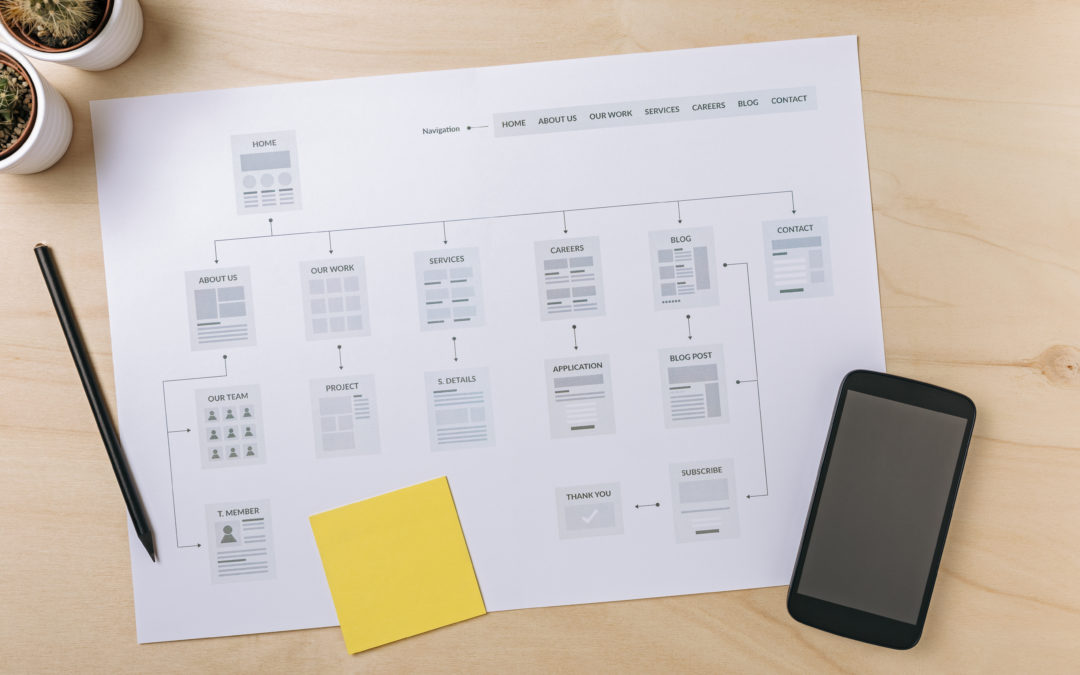
My 2019 NAMPC Newbie Experience
*This blog post has been featured on the Americans for the Arts ARTSBLOG.
The 2019 National Arts Marketing Project Conference in Miami, FL was my 1st arts administration conference and I had a wonderful time! Over the course of four days, there were insightful speakers, amazing artists, and vibrant cultural destinations, not to mention delicious food, fun, and new friends. As an individual artist cultivating diverse audiences as well as an entrepreneur serving clients across the arts ecosystem, #NAMPC was the most ideal professional development for both my artistic and administrative growth. This photo essay is a summary of my experience and takeaways to build diverse and vibrant arts communities through the power of equitable storytelling and inclusive collaborations.
Disclaimer: My choice of sessions to cover was based solely on personal preference, not an objective judgment of superiority.
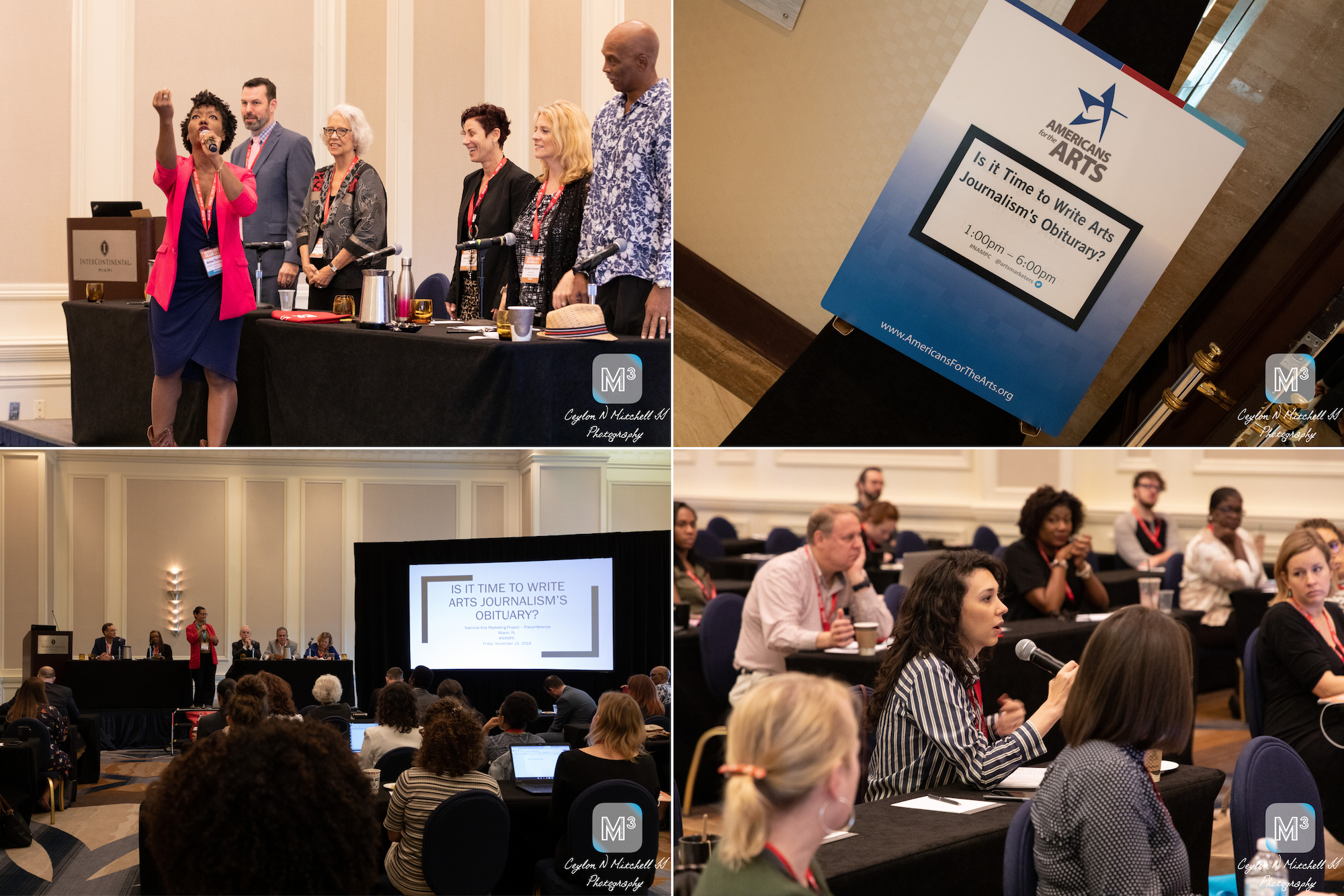
Moments of the “Is It Time to Write Arts Journalism’s Obituary?” Preconference session. Photos by Ceylon Mitchell.
Since the mid-200s, Arts and Culture journalism has been on a decline. As revenue decreased for news outlets, the number of arts features decreased and the quality diminished, to the disappointment of local readers. Many seasoned arts writers have been forced to either change their topics entirely or work solely for national publications through media consolidation. How did the city of Miami deal with this national lack of local coverage of their arts community? “Necessity is the mother of invention” and Miami arts readers craved local coverage. As a result, the Arts & Business Council of Miami innovated and created Artburst Miami, a one-stop source for dance, music, theater and independent film coverage in Miami-Dade County through multi-media content with over a dozen arts writers. This bilingual online news bureau gave life to practicing arts journalists who lose work at traditional newspapers, and gave coverage to an entire arts community. In times of trouble it is crucial to innovate or die, and Artburst proved to be a successful example of that lesson. Other takeaways for arts marketers included:
- Build a “ride or die” list of media partners, including non-traditional outlets.
- When sending out PR content to journalists, “think about their need and audience, not your own exposure.”
- Anyone can be the “press” so you should also be your own news outlet.
- Highlight and celebrate other organizations in your community.
- Cultural diversity is a gem. Use it!
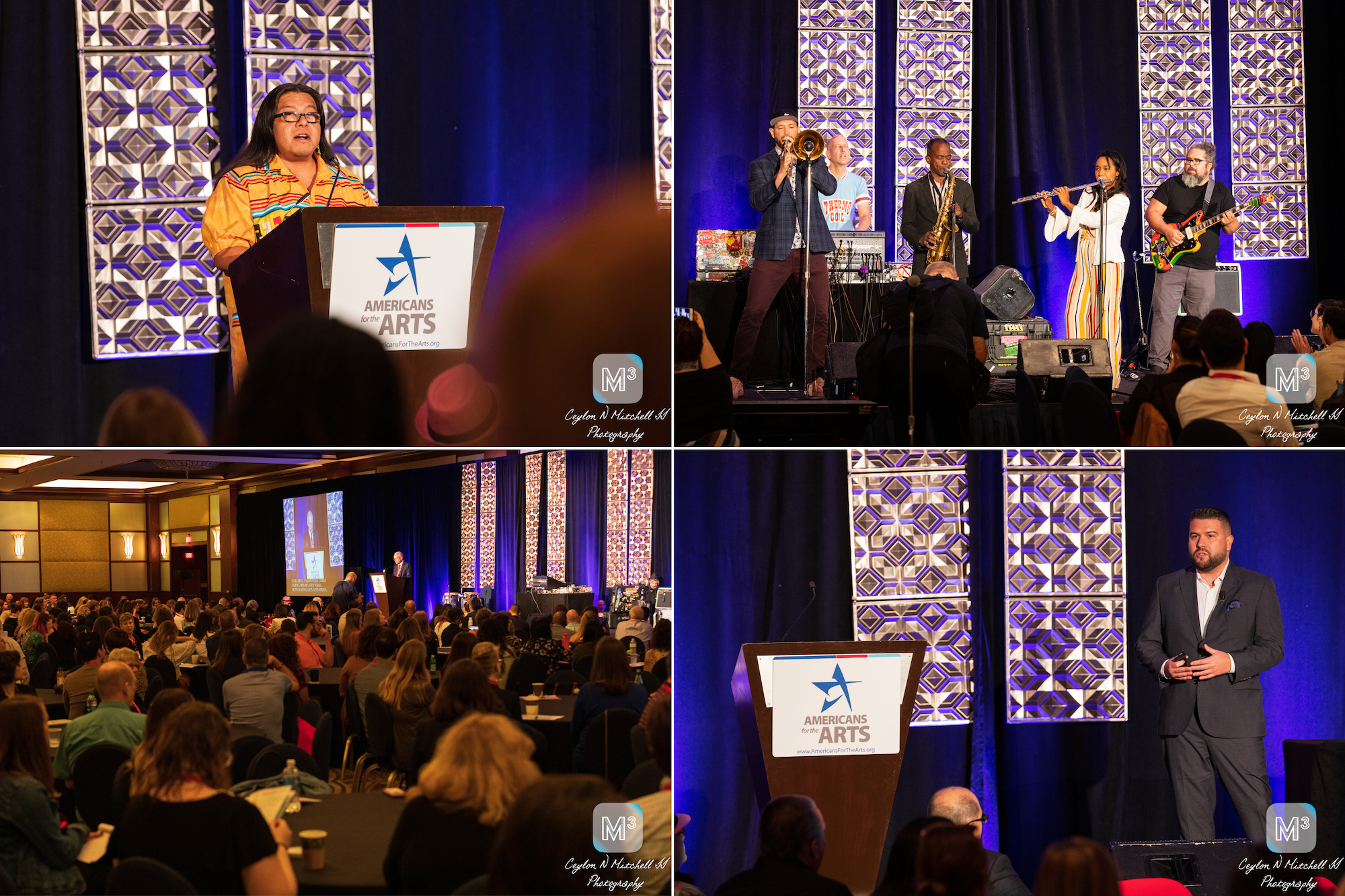
Moments of Saturday’s Opening Keynote with Carlos Gil. Photos by Ceylon Mitchell.
Saturday’s keynote opened with wonderful remarks, an impactful land acknowledgement from Rev. Houston Cypress, and a music performance from the Spam Allstars. Carlos Gil, the keynote speaker and an acclaimed author, taught us all how to put the “social” back into social media and stay relevant in a crowded digital landscape. He broke down his presentation into Content (the psychology of what your audience sees, feels, and reacts to) or “scripted business theatre”, Community (the people who will amplify and humanize your brand such as employees and customers), Consistency (how often you share relevant content and engage), and Conversion (creating scarcity that sells and proves a ROI from valuable content). With an engaging personality and a PowerPoint filled with pop culture references, Carlos summarized the presentation with two lists of guidelines:
DJ Khaled Keys To Social Media Success:
- Why Are You On Social Media? Don’t Play Yourself.
- Don’t Think Like a Marketer, Think Like a Fan.
- Who Are You Trying to Reach? You Can’t Appeal To Everyone.
- Social Media Never Sleeps, Even When You’re Away
- Create Relevant Content That Your Audience Wants. Major Key.
- Be Loyal To Your Audience And They’ll Be Loyal To You.
- Community is King and Content is Queen.
Storytelling:
- What’s Your Objective?
- Pick Your Channel.
- Select Your Storytellers (Employees, Fans, Influencers).
- Storyboard Your Content: Have A Beginning, Middle, And End.
- Take Viewers Behind The Scenes.
- Ask Your Community To Share or Take Action.
- Own The Screen and Have Fun!

Lori Brooks and Luke Atkinson of Oklahoma Contemporary Arts Center lead the “Grow Your Brand Through Storytelling” workshop. Photo by Ceylon Mitchell.
In the “Grow Your Brand Through Storytelling” session, Lori Brooks and Luke Atkinson of Oklahoma Contemporary Arts Center led an interactive workshop that challenged attendants to think about the values of their organizations in a few words, formulate the ideal experiences of their customers in a clear statement, and create online messaging that reinforces those narratives. With regards to fundraising campaigns, they encouraged participants to use their stakeholders and customers (students, individual artists, educators, staff, etc) to tell the story in the most authentic and impactful way. Engaged audiences can also give arts marketers news stories through user-generated content. In my group, one strategy idea was to record a live video on social media of a traditional video interview with a stakeholder and then repurpose that content through a press release, quote graphics, Q&A, and other media. Finally, when looking for stories to tell, the presenters gave the attendants these strategies:
- Interview key stakeholders
- Surveys
- Use your space for conversations
- Look at social media engagement
- Target audience anecdotes

Ceci Dadisman and Kristie Swink Benson present “A Tactical Guide to Achieving Engagement with Diverse Audiences” workshop. Photo by Ceylon Mitchell.
The average demographic of most current arts audiences does not reflect the diverse makeup of our communities. Using Palm Beach Opera in West Palm Beach, FL and The High Museum in Atlanta, GA as case studies, Ceci Dadisman and Kristie Swink Benson showed that arts organizations need authentic community partnerships with inclusive language and accessible programming in order to ensure sustainability and relevance with audiences from diverse backgrounds. Initial studies by Palm Beach Opera revealed that barriers to cultural participation included:
- It’s not for someone like me
- I didn’t think of it
- It’s inconvenient
- I couldn’t find anybody to go with
- Its value is not worth the cost
In order to engage the African American community and increase attendance at the Opera’s events, Palm Beach Opera eventually partnered with the Mosaic Group, a full-service marketing and public relations firm with a reach to with diverse markets, including Hispanic, African-American, and Caribbean consumers. Initial community feedback for the High Museum revealed that it had no brand presence in nonwhite communities, multicultural audiences did not see themselves reflected in the marketing, and the organization was considered exceptional but not essential. In order for visitors to more closely mirror the population of the Atlanta metro area, the High Museum implemented the following strategies:
- Do listen to your audience and make adjustments (programming, marketing, outreach, etc.).
- Do communicate programming offerings often and comprehensively.
- Do make your brand visible.
- Do curate experiences that are fun, inclusive, and accessible.
- Don’t assume you know what your audience thinks/feels about you.
- Don’t limit your communication to once or twice a year (cultivate the relationship regularly).
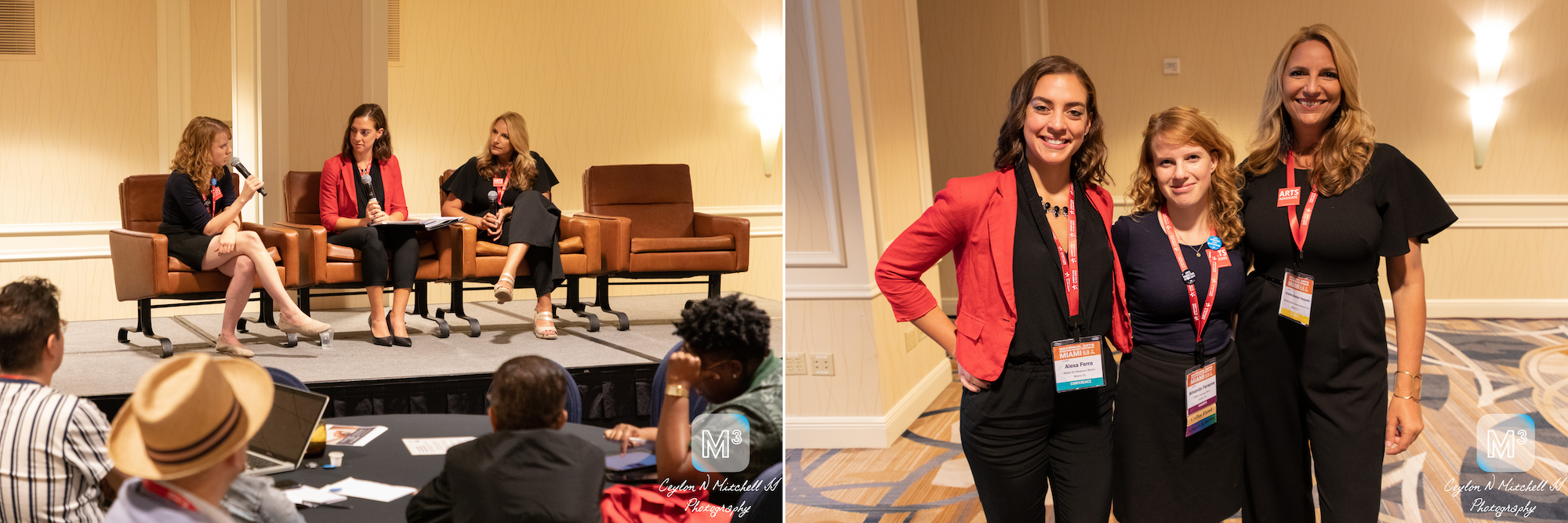
Amanda Faraone, Alexa Ferra, and Christina Boomer Vazquez lead “Telling the Bigger Story” session. Photos by Ceylon Mitchell.
When planning and marketing PR campaigns, it’s important to position the arts as a vital part of the broader public that strengthens, enlightens, and connects communities. If we want the public to have a shared responsibility and ownership of the arts in our communities, we must be inclusive of a variety of voices from a variety of sources at the beginning stages of our programming planning. When we contribute to a thriving arts sector with our campaigns, we help to create ripple effects of benefits throughout the community. Arts and culture benefit cities, both economically and culturally. For the Perez Art Museum Miami (PAMM), they told their story about providing student passes for local youth by using video storytelling and leveraging social conversation. The organization focused on arts education and cultural tourism as a means to advocate for the necessity of arts activity and leverage its distinct, local assets. With an Integrated Communications Cycle, PAMM used the following process:
- Understand (needs, objectives, environment)
- Plan (strategy, target audiences, timeline)
- Create (messaging and visuals for channels)
- Communicate (distribution tactics)
- Measure (analytics and adjustments)
- Repeat
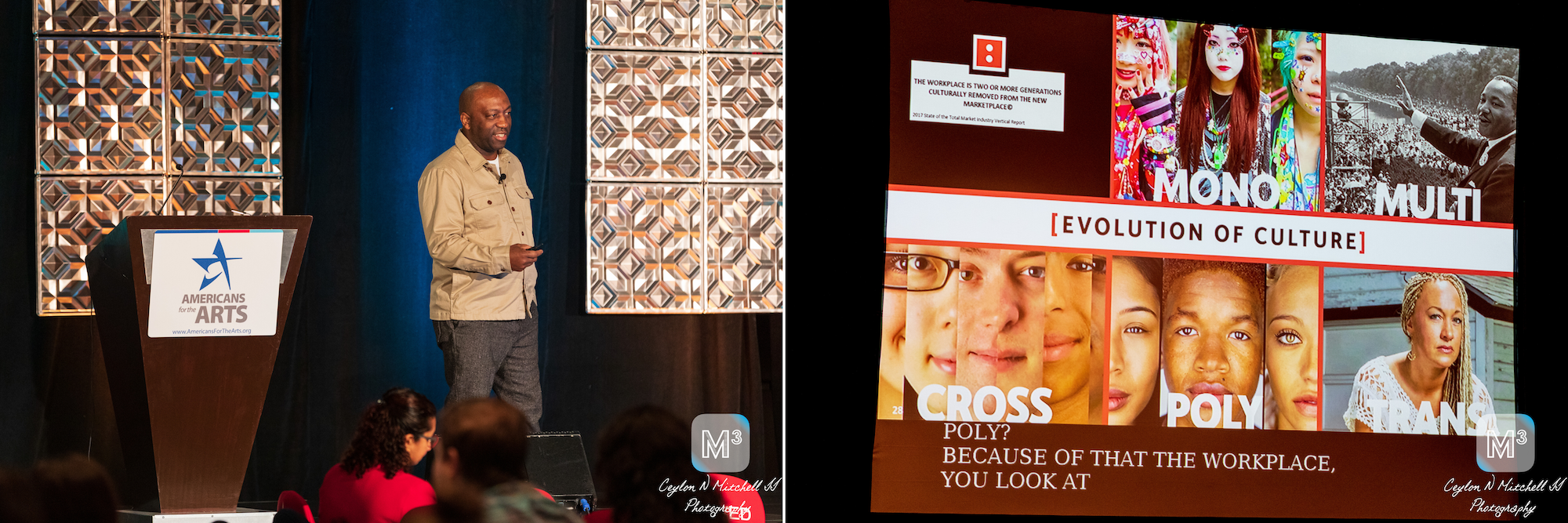
Sunday’s Keynote with Jeffrey L. Bowman. Photos by Ceylon Mitchell.
Multicultural audiences are The New Majority in the United States and marketers must adapt. What once started as a mono-cultural market in the 1930s has now transitioned to a cross-cultural and poly-cultural market that consists of a variety of attitudes and behaviors in people. Going forward marketers must:
- Build an ecosystem
- Modernize or die
- Reposition within competition
- Bet on consumer growth
- Build culture from within with resources
- Use direct channels (one-to-one)
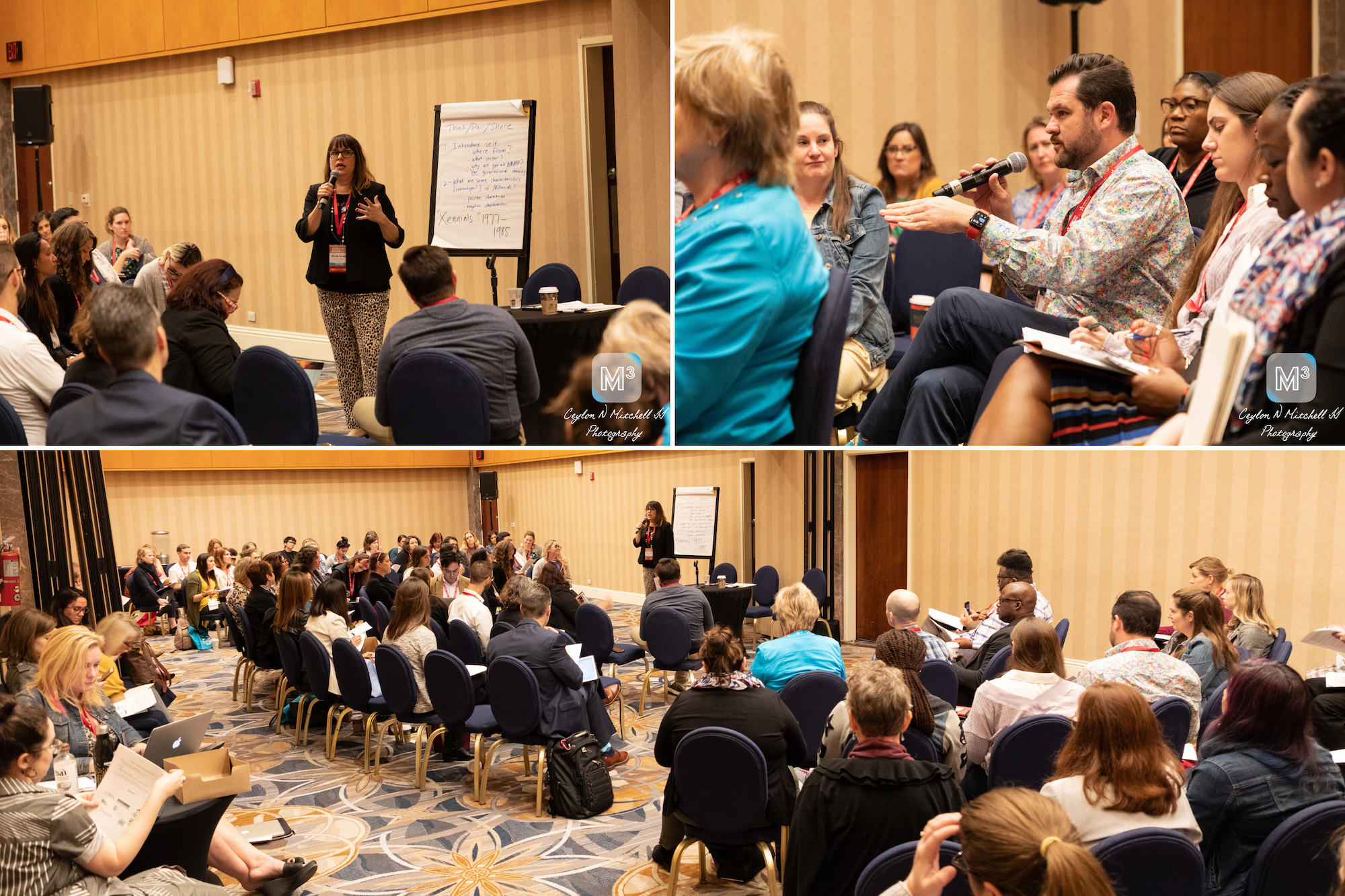
Dr. Wendy Givoglu leads the “Orlando as a Case Study for Arts Participation and Social Media Engagement Among Millennials” session. Photos by Ceylon Mitchell.
“The characteristics of participatory culture and democratization brought on by the evolution of emerging digital entertainment and social media communications technology, coupled with the power of the millennial generation (the largest generation present in the American workforce today)…are not only two forces that can be nonprofit arts organizations’ biggest resources but are two forces that are already inherently at play within the DNA of the arts.” According to data collected by Dr. Wendy Givoglu from a 2018 survey in Central Florida, millennials are more likely to attend an arts event if:
- The cost – if it was lower
- The cost – if it was free
- Knowing people in the cast or knowing the performers/artists
- The time of day – if there were more options (not just Friday and Saturday nights and Sunday matinees or Monday-Friday 9-5 hours of operations)
- More information – if I knew the backstory of the performance or art
When seeking to further arts engagement with millennials, non-profit arts organizations should pursue the following recommendations:
- Tell the stories of all – artists, impact, jobs, art, patrons, people, and place – start and share the transmedia story.
- Consider and share how the arts create and convene around causes.
- Understand, program, and communicate with consideration of the lifecycles and interests of millennials, including both family (is there food?) and non-parenting lifestyles.
- Consider diversity and cultural equity in the arts, and use social media to share examples of best practices (thought leadership). It’s not about programming. It’s about your organization’s identity.
- Create and sustain experiences that define engagement in the digital and physical worlds.
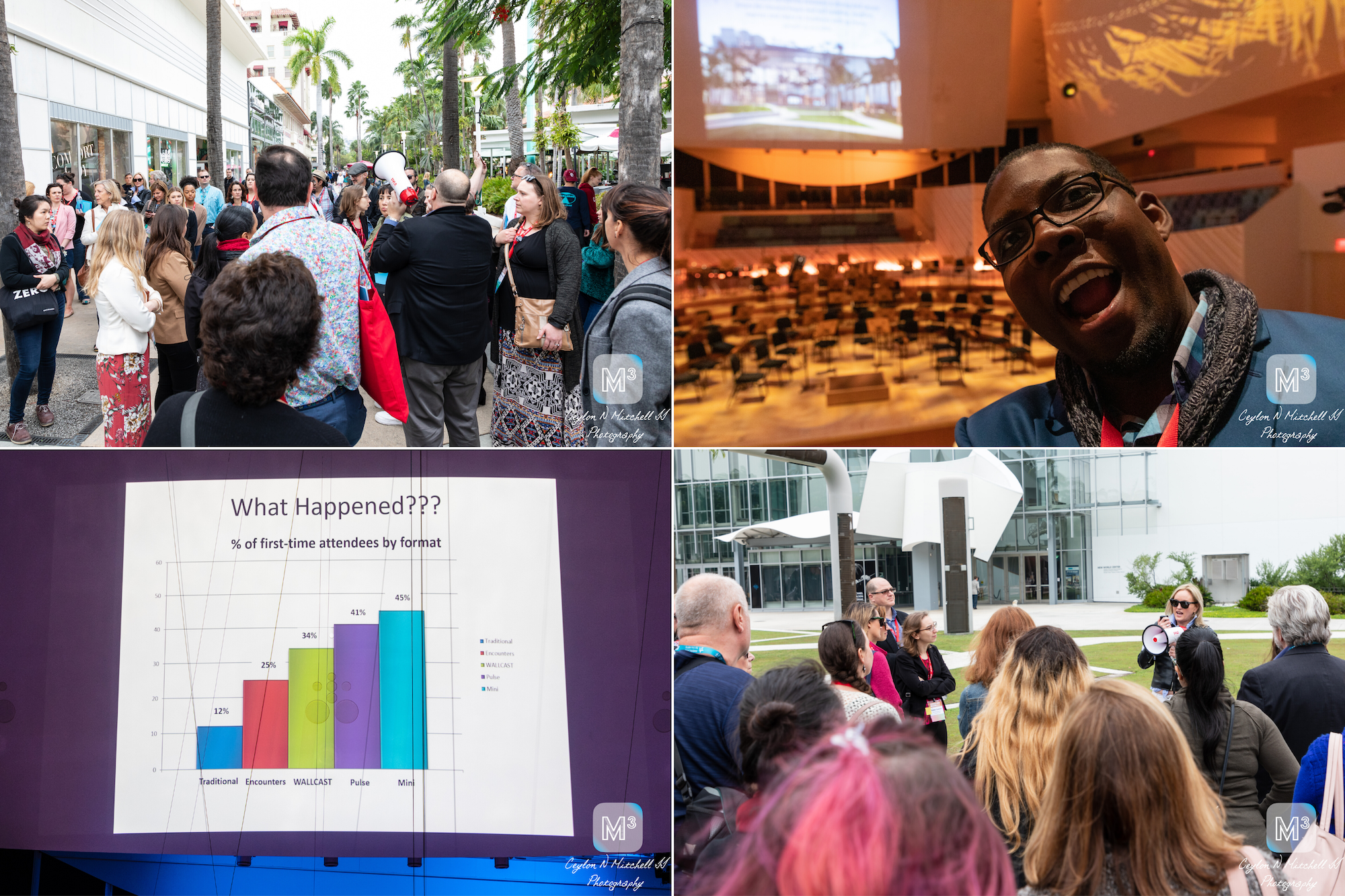
“How Art Changes a Tourism Corridor (Miami Beach)” off-site session. Photos by Ceylon Mitchell.
In Miami Beach, destinations such as the iconic Lincoln Road pedestrian mall and New World Center have revitalized the area since the 1990s. As America’s Orchestral Academy, the New World Symphony creates difference experiences for different audiences. Whether they engage in a traditional concert format, watch concerts outside with the state-of-the-art WALLCAST, or enjoy the nightclub-meets-symphony atmosphere of Pulse, the New World Symphony has seen an increase in attendance across the board with its innovate ways of marketing classical music.
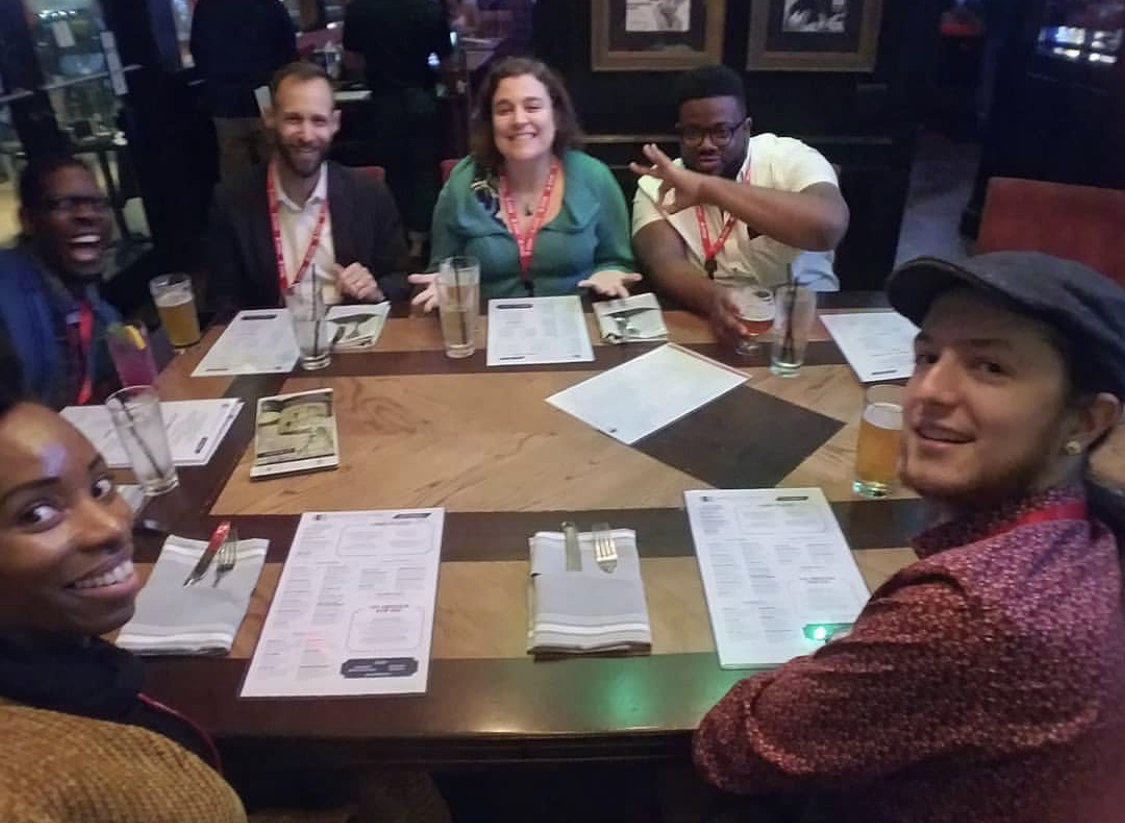
Dine-Around Dinner: Artists as Entrepreneurs
I enjoyed a fun and delicious meal with fellow artist/arts marketers at the American Social restaurant in Miami, FL. My group and I discussed strategies and creative ways to empower the artists that we serve. Our lively conversation covered entrepreneurial topics from photography and EPKs to business incorporation and contract negotiations.
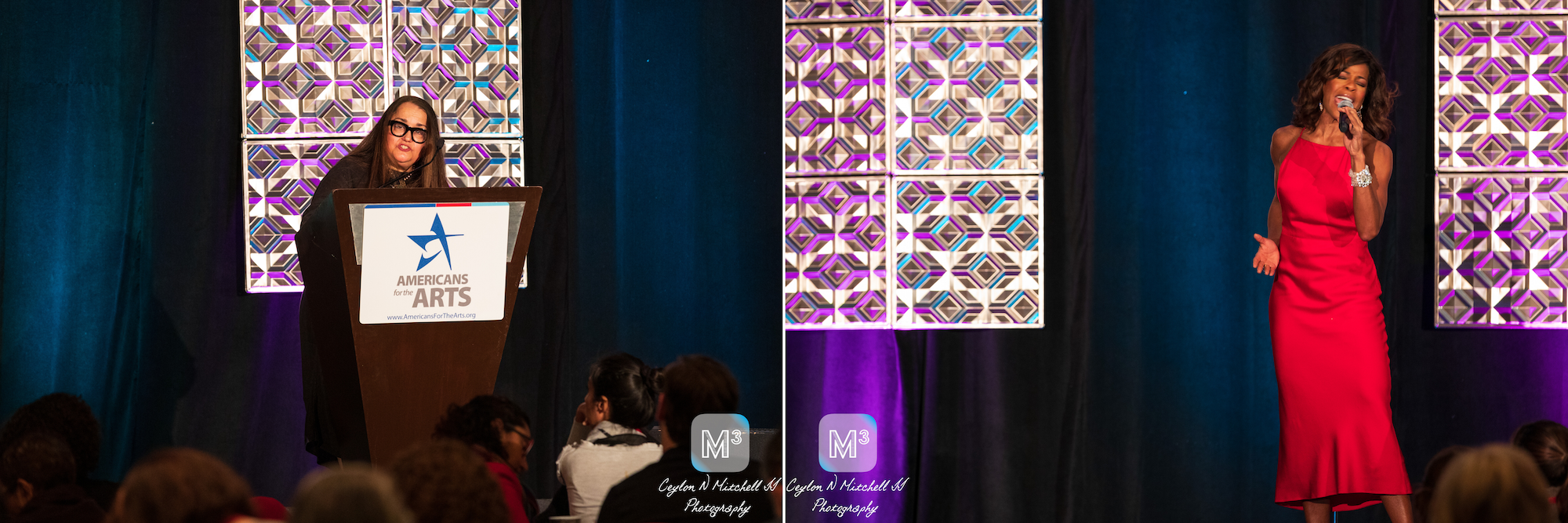
Monday’s Closing Keynote with Laurie Woolery and Nicole Henry. Photos by Ceylon Mitchell.
As the Director of Public Works at The Public Theater, Laurie Woolery concluded the National Arts Marketing Project Conference with the core theme of authentic community partnerships. When arts institutions are “more like community centers instead of country clubs,” trust is built between diverse groups, people show up, and cultural transformation occurs. Laurie provided many key takeaways for arts marketers:
- Widen the scope of who’s involved.
- Bring in, listen, and describe community how they would describe themselves.
- Learn people’s names and pronouns.
- Celebrate that they made it.
- Make your space warm, joyful, and rigorous.
- FEED PEOPLE! Food is the get unifier. Make sure it’s great and healthy.
- Treat people as VIPs.
- Start on time, do rigorous work, and end on time.
- Community is a leap of faith worth taking.
- It’s not about getting it right, it’s about being authentic.
- Change is inevitable…Transformation is a choice.
Thank you for reliving my #NAMPC 2019 journey. View more photos here. I encourage you to stay connected with the National Arts Marketing Project and attend the next conference in Chicago in 2020!




